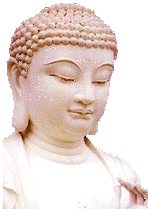
|
|

-
Stilling The Mind A Healthful Practice
Diane
Evans
- --o0o--
The Beacon Journal,
Sep. 02, 2003
- Brain scans show how meditation cuts stress
-
Akron, Ohio
(USA) -- Recently, in speaking before a luncheon audience, I mentioned
that I try to meditate for about 10 minutes every morning and 10
minutes before bedtime.
-
"How do you
meditate?'' a woman asked.
-
I felt so
ill equipped to answer, because I'm new to it, too, as many Westerners
are.
-
Yet, you know
meditation has penetrated our culture when Time magazine devotes a
cover story to it, as happened recently.
-
Time reported
that 10 million American adults now say they meditate regularly in one
way or another -- twice as many as 10 years ago.
-
"It's
becoming increasingly hard to avoid meditation,'' the article said.
"It's offered in schools, hospitals, law firms, government buildings,
corporate offices and prisons.''
-
Further, new
research using sophisticated imaging techniques suggests that
meditation can alter brain activity in a way that reduces stress.
-
It's as if
science, once again, is validating an ancient practice. East and West
find common ground.
-
Buddhist
concepts
-
The late
philosopher Karl Jaspers, in writing about Buddhist teachings,
described a doctrine whereby truths are reinforced and established
only by meditation. In Jaspers' words, this involves the carrying of
``light into the depth'' and the creation of an awareness that
``illumines the unconscious down to the last nook and cranny.''
-
Buddhism
teaches that meditation is a cultivation of concentration, and a state
of wakefulness. In the book Destructive Emotions, thought-free
wakefulness is described as the mind being ``open, vast and aware,
with no intentional mental activity. This mind is not focused on
anything, yet totally present -- not in a focused way, just very open
and undistracted.''
-
Thus, the big
challenge: How to still our thoughts, quit the mental conversations we
have with ourselves, and just hush up.
-
There are so
many techniques and forms of meditation. Centering prayer, for
example, is a common Christian form. It often involves repeating a
mantra -- a single word or phrase over and over -- while pushing all
other thoughts aside. (To be sure, the repeating of a mantra is common
in other forms of meditation as well.)
-
I first
tried centering prayer nearly two years ago, after hearing about it in
a scripture study class at my church. For nearly a year, I had almost
no success; thoughts kept coming into my mind, and it was difficult to
set them aside for more than a minute or two
-
Meditative
process
-
It wasn't
until I read Wayne Dyer's book, There's A Spiritual Solution To Every
Problem, that I started to make progress. It's not a how-to book on
meditation -- but meditation is explained throughout in various
passages. Dyer helped me understand that at least in part, meditation
is a process of moving into the gap between your own thoughts
-
. "When we
empty our mind of our ego-driven thoughts we invite forgiveness into
our earts,'' he wrote. ``And by letting go of the lower energies of
hatred, shame and revenge, we create a mind-set of problem
resolution.''
-
But, oh, it's
not easy.
-
In his book
Contemplative Prayer, the late Trappist monk Thomas Merton got down to
the practical difficulty of meditation.
-
"One cannot
begin to face the real difficulties of the life of prayer and
meditation unless one is first perfectly content to be a beginner and
really experience himself as one who knows little or nothing, and has
a desperate need to learn the bare rudiments,'' Merton said. ``We do
not want to be beginners. But let us be convinced of the fact that we
will never be anything else but beginners, all our life!
-
How to meditate?
-
Practice,
practice.
-
Source:
http://www.buddhistnews.tv
--o0o--
|
|

